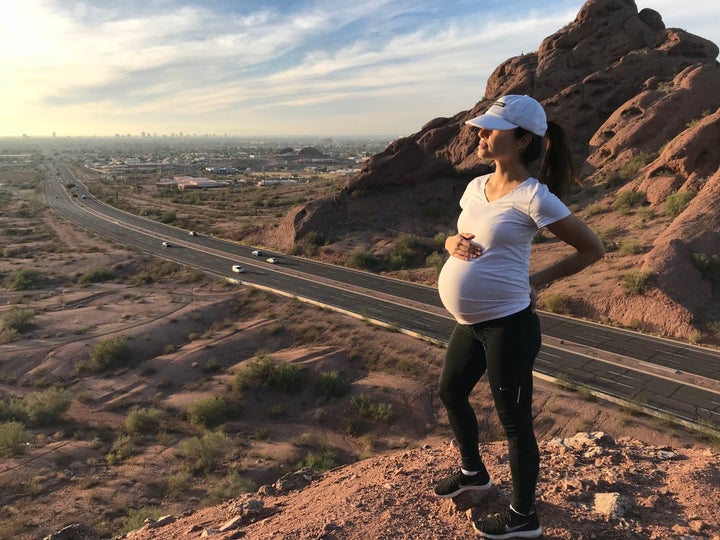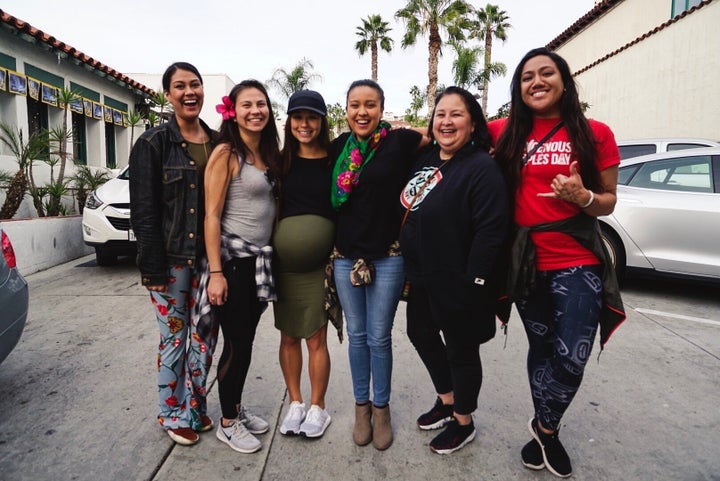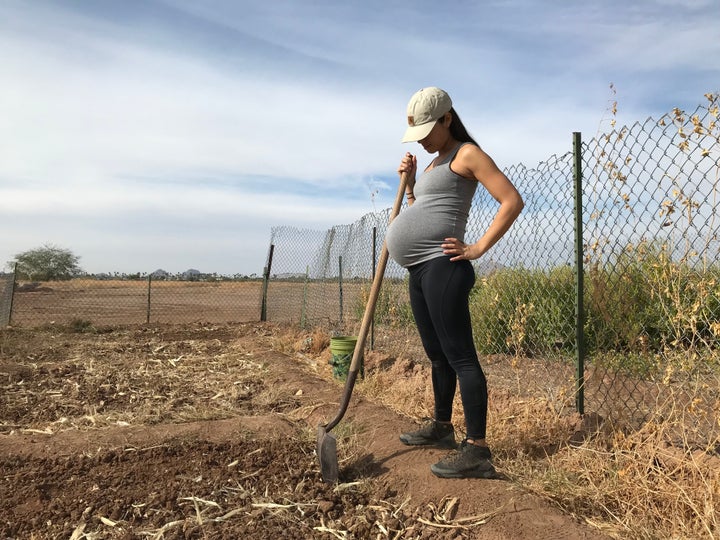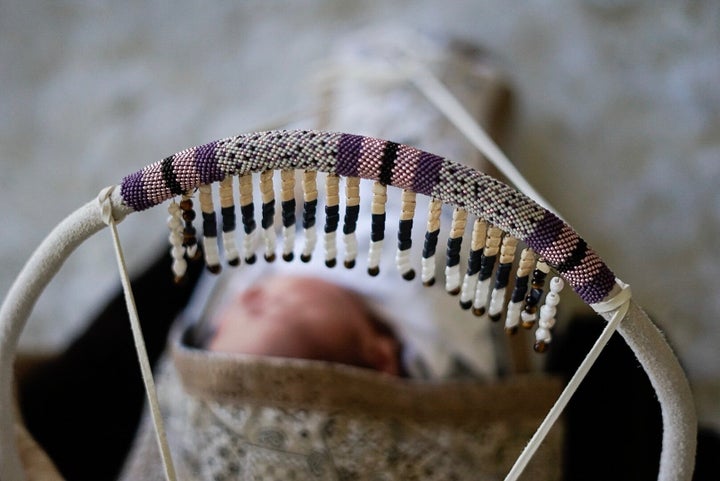
Three years ago, my husband and I found out we were expecting our firstborn. Before we even told our families, my husband made a phone call right away to a spiritual advisor to say he could no longer participate in a ceremony he’d helped to plan.
According to traditional teachings, expectant parents must stay away from ceremonial events that could spiritually interfere with the child’s wellbeing. And from the very start, we did our best to honour all the prenatal guidelines from each of our Indigenous nations (he is On Akimel O’odham from Salt River, AZ; I am Anishinaabe and Lakota from North Dakota).
Like many other First Nations and Native American parents of our generation across Canada and the USA, we are doing everything we can to reclaim culturally significant pregnancy and birthing practices. Reintegrating these into our modern intertribal family lifestyle has been an empowering process of cultural revitalization and healing.
Ancestral practices for modern families
Traditional Indigenous pregnancy and birthing practices are healthful, holistic, and increasingly relevant in today’s world. They are also incredibly diverse. Each of the hundreds of tribal nations in North America carry unique parenting teachings; and within those nations, individual families also interpret the teachings differently.
One example of the subtle differences in perspectives can be found in the language around midwifery. In most Canadian Indigenous communities, traditionally the person who delivers babies ― the midwife ― is an experienced and trusted elderly woman. However, the term “midwife” holds slightly different meanings to different Nations, as is evident from literal translations of the English word.
“My generation is increasingly reclaiming ancestral beliefs ― viewing menstrual cycles, sex and pregnancy through the lens of beauty and power.”
In the Mohawk language, it signifies “she who pulls the baby out of the earth.”
In the Nishnawbe Aski Nation, the word do-di-sem is often used, and this emphasizes the spiritual connection between the midwife and the child, once the umbilical cord is cut.
For the Nuu-chah-nulth of British Columbia it translates as “she who can do everything.”
Though her role is interpreted somewhat differently, the midwife is nonetheless universally revered.
Reclaiming fertility and sex
In many Indigenous cultures, sex is considered a powerful exchange of energy ― something to be enjoyed by both partners, but not taken lightly, because it is the first step in creating a new life.
Our ancestors honoured a girl’s first menstrual cycle through coming-of-age ceremonies, and a woman was revered for her power during her “moon time.”
My generation is increasingly reclaiming ancestral beliefs ― viewing menstrual cycles, sex and pregnancy through the lens of beauty and power, without the stigma or negative associations imposed in post-colonial times.
Across Canada, the reclamation of moon time ceremonies ― at home, or even on University campuses ― has been one way of honouring these values. And on Indigenous Instagram, through pages like Indigenous Motherhood or the account of artist and childbirth educator Wakeah Jhane, it is also common to find beautiful, artistic portrayals of proudly pregnant Indigenous women.
The sacredness of pregnancy
From the moment of conception, the mother is viewed as a “life giver.” This perspective is carried throughout the gestational period. Fatherhood is also considered sacred, and the expectant father is required to follow guidelines and take certain precautions, just as the expectant mother is.
During pregnancy, many tribes teach that the parents-to-be should stay away from violence, death, and blood. This includes hunting, funerals, killing animals ― even insects ― and warfare.
Nowadays it also applies to violent imagery (like fight scenes in TV shows and movies). My husband and I are both big fans of action and war stories. We had been in the middle of Season 2 of “Fargo” ― a super entertaining TV show that also happens to be super gory. As tempting as it was to continue, we decided to pull ourselves back from the edge of our seats and stop watching it altogether, to ensure that the thoughts and actions surrounding our baby were peaceful.
Like many Indigenous cultural teachings encourage, we also chose to stay away from crowds, parties, festivals, and anywhere that there was any chance of chaos. We spent a lot of time at home, so I took up sewing, and we watched movies that were more peaceful in nature.
Spiritual babyproofing
A “spiritual babyproofing” of the home often takes place, in which sacred medicines like sage and se’goi (greasewood) are used to cleanse the space frequently prior to the baby’s arrival.
Many people also choose to remove harmful substances, like alcohol, toxic cleaning products and even unhealthy foods from the home.
Some tribes teach very specific precautionary protocol such as not wearing anything tight around the neck or tying any knots. This is said to prevent the knotting of the umbilical cord.
“He sang to her and spoke to her in O’odham so that the first words she heard came from the original language of the land.”
Ancestral birthing practices
Indigenous women today are increasingly seeking out Indigenous birthing facilities and practitioners ― though culturally appropriate resources are not always easy to find.
I went through my own struggle finding appropriate prenatal health care: I started seeing a non-Native doctor at a tribal clinic, whom I found to be condescending. I needed a provider who respected me, my family and my culture, so I sought referrals from my community and ultimately switched to a birthing centre where I found a midwife who offered culturally relevant services. My midwife was non-Native, but I felt comfortable with her because she expressed respect for traditional birthing practices.
In the end, I had to have an emergency C-section at a third facility ― an Indian Health Service hospital. Thankfully, this hospital offered the balance of much-needed western medical care for my situation and a staff of Native nurses and doctors who allowed us to incorporate traditional practices into our baby’s birth, like smudging our space with sage and cutting the umbilical cord with obsidian.
From the Inuit territories in Northern Canada to the Navajo Nation in Arizona, Indigenous midwifery and doula programs are growing, and the efficacy of their services is being recognized.
Not only are these services comforting and empowering, they can also be safer. Native American and First Nations women have higher rates of maternal mortality and other adverse outcomes in medical care. As midwife and leadership circle co-chair Carol Couchi, of The National Council of Aboriginal Midwives explains, on her organization’s website:
“We are not just about catching babies. We are nutrition. We are safety in remote areas. We are insurance for young families.”
Indigenous birthing resources

Tradition-informed wellness and self-care
Even where more formal Indigenous-oriented prenatal health care is not available, some expectant parents independently incorporate ancestral teachings into their pregnancy wellness routine and birthing process.
A universal Indigenous perspective is to view pregnancy and birth as normal processes of life, as opposed to conditions that, by default, require medical interventions.
Some expectant parents consume medicinal plants and ancestral foods to boost their well-being. Eating healthy staples like salmon; traditional dishes such as stews; and locally harvested wild foods is said to nourish the baby and mother in both the nutritional and spiritual sense.
And for the delivery, some labouring parents opt for non-pharmaceutical pain management, using breathing techniques and staging a calm setting with dimmed lighting and taking sacred medicines rather than having an epidural. They may give birth in squatting or kneeling positions as opposed to lying down.

Baby’s first hours
When my daughter was born, my husband held her first while I recovered, and he did “skin-to-skin” as advised by our care providers at the Phoenix Indian Medical Center. He sang to her and spoke to her in O’odham so that the first words she heard came from the original language of the land.
I remember drowsily waking up from my surgery to the scent of sage ― an immediate comfort ― and the sight of my mom, my husband’s family, and an elderly Hopi nurse who handed me my daughter for the first time. My birth certainly did not turn out exactly how I wanted it to, but I was grateful for our safety, our health, and the pieces of my culture that we were able to carry with us.
A small victory: my daughter latched instantly, without pain or discomfort on my end. “I have seen hundreds of babies born, but have never seen one latch so quickly!” the Hopi nurse said. I will always remember her encouragement. I felt safe with a grandma by my side.

Collective healing
My hope for the future is to see more Native children being raised in peaceful, safe environments in which their culture and heritage is upheld, honoured, and respected not only by their families but by the world around them. Racism and the impacts of colonialism continue to harm the health of Indigenous families, but so much work is being done to heal collectively.
I believe that reconnecting with our Indigenous pregnancy and birthing practices is an important part of this healing.
WATCH: Indigenous artists showcase Canadian provinces in new ways.